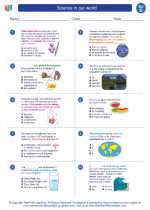Medium in Science
In science, the term "medium" refers to the substance through which energy, such as light or sound, can travel. The properties of the medium affect how the energy is transmitted and can have a significant impact on its behavior.
Types of Medium
There are different types of mediums in science:
- Solid: In a solid medium, particles are closely packed together and vibrate, allowing energy to be transmitted as waves.
- Liquid: In a liquid medium, particles are more spread out than in a solid, and the movement of the particles allows for the transmission of energy.
- Gas: In a gaseous medium, particles are far apart and move freely, enabling energy to travel through the medium in the form of waves or vibrations.
Properties of Medium
The properties of a medium can influence how energy moves through it. Some important properties include:
- Density: The compactness of the particles in the medium affects the speed and behavior of energy transmission.
- Stiffness: This property determines how well a medium can transmit mechanical waves, such as sound waves.
- Temperature: The temperature of a medium can impact its density and, consequently, the speed of energy transmission.
- State of Matter: Whether a medium is a solid, liquid, or gas influences how energy can move through it.
Examples of Mediums
Some common examples of mediums and the energy they can transmit include:
- Air: Air is a medium through which sound waves can travel.
- Water: Water serves as a medium for the transmission of both sound waves and light waves.
- Glass: Glass can transmit light waves, making it a medium for the passage of visible light.
Study Guide
When studying the concept of medium in science, consider the following questions:
- What are the different types of mediums in science, and how do they differ from one another?
- How do the properties of a medium impact the transmission of energy through it?
- What are some real-world examples of mediums and the types of energy they can transmit?
Understanding the role of mediums in energy transmission is crucial to various scientific fields, including physics, chemistry, and environmental science.
[Medium] Related Worksheets and Study Guides:
.◂Science Worksheets and Study Guides Fourth Grade. Science in our world
Study Guide Science in our world - 4th gr.
Science in our world - 4th gr.  Worksheet/Answer key
Worksheet/Answer key Science in our world - 4th gr.
Science in our world - 4th gr.  Worksheet/Answer key
Worksheet/Answer key Science in our world - 4th gr.
Science in our world - 4th gr.  Worksheet/Answer key
Worksheet/Answer key Science in our world - 4th gr.
Science in our world - 4th gr.  Vocabulary/Answer key
Vocabulary/Answer key Science in our world - 4th gr.
Science in our world - 4th gr. 

 Worksheet/Answer key
Worksheet/Answer key
 Worksheet/Answer key
Worksheet/Answer key
 Worksheet/Answer key
Worksheet/Answer key
 Vocabulary/Answer key
Vocabulary/Answer key

The resources above cover the following skills:
History and Nature of Science: A student should understand the history and nature of science. A student who meets the content standard should:
Develop an understanding that historical perspectives of scientific explanations demonstrate that scientific knowledge changes over time, building on prior knowledge.
Develop an understanding that scientific knowledge is ongoing and subject to change as new evidence becomes available through experimental and/or observational confirmation(s).